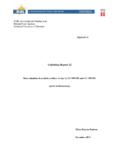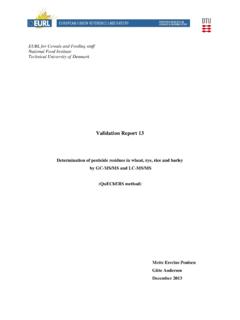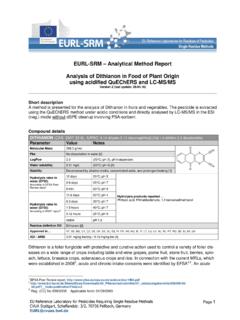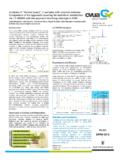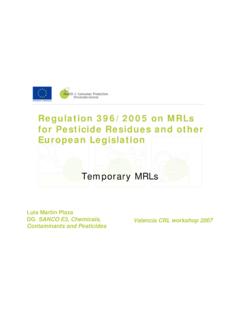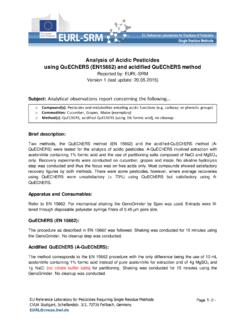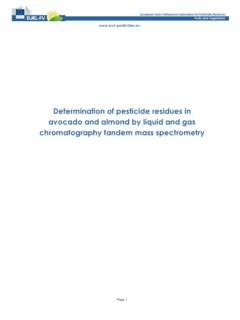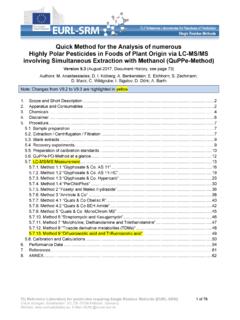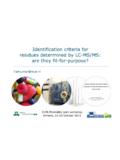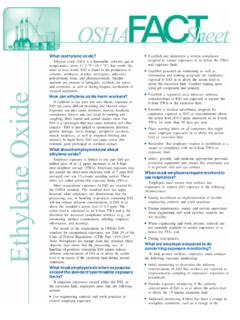Transcription of EURL-SRM - Analytical Observations Report
1 Community Reference Laboratory for Single Residue Methods CVUA Stuttgart, Schaflandstr. 3/2, 70736 Fellbach, Germany Page 1- 2 - EURL-SRM - Analytical Observations Report Concerning the o Compound(s): ethylene oxide (EO), 2-Chloroethanol (2CE) o Commodities: Sesame seeds o Extraction Method(s): QuOil, QuECHERS o Instrumental analysis: GC-MS/MS Analysis of ethylene oxide and its Metabolite 2-Chloroethanol by the QuOil or the QuEChERS Method and GC-MS/MS Version (December 2020) Background information / Initial Observations : In late August 2020, Belgium initiated a RASFF notification concerning residues of the unauthorized substance ethylene oxide (EO) in various lots of sesame seeds from India at levels up to 186 mg/kg. On 9 September 2020, a notification this concerning was published in the RASFF portal ( ). The affected products were delivered to several member states and were used for the production of various processed foodstuffs.
2 Until 20 November 2020, roughly 140 notifications concerning EO in sesame from India were notified within the RASFF portal with two of them being border rejections. These notifications originated from 17 different EU-Member states and 2 EFTA countries1. The EO-levels encountered in the sesame samples mostly ranged between and 10 mg/kg, all exceeding the EU-MRL (maximum residue limit) of mg/kg. For how long EO-fumigation has been in use or increasingly applied to sesame seeds in India will need to be investigated. In a review paper from 2004 concerning fumigation of oily seeds with focus on India2, methyl bromide and phosphine are reported as the main fumigants used in India for oilseeds. The alternatives discussed in this review do not include EO. Given the strong antibacterial properties of EO (reportedly 10-fold more effective than methyl bromide3), it is conceivable that EO-fumigations may have been initiated in India as a counter-measure for reducing the incidences of sesame seed contaminations with salmonella and other fecal bacteria.
3 These contaminations have led to numerous border rejections of sesame seeds from India by EU Member States in the past two decades. Looking at the RASFF portal,4 the first three notifications on salmonella in sesame seeds were launched by 1 Austria, Belgium, Croatia, Czech Republic, Finland, France, Italy, Germany, Latvia, Luxemburg, Poland, Slovenia, Spain, Sweden, The Netherlands, Norway Switzerland. 2 Somiahnadar Rajendran, Chayadevi HS; Oilseeds -Storage and Insect Pest Control, JFST (2004); 41(4):359-367 3 Richardson and H. A. U. Monro; Fumigation of jute bags with ethylene oxide and methyl bromide to eradicate potato ring rot bacteria. Appl. : 448451 (1962) 4 EU Reference Laboratory for Pesticides Requiring Single Residue Methods Page 2 Germany in 2001. The first border rejections were reported by Greece in 2007.
4 By 20 November 2020 most RASFF-notifications concerning salmonella and other bacteria in sesame seeds were notified by Greece (60) followed by Italy and Poland (45 each), Germany (34) and The Netherlands (23). On 1 October 2014, a modification of Regulation (EC) No 669/2009 came into force requiring an in-creased level of import controls on sesame seeds from India with 20% of lots being required to be checked for salmonella. Thereafter, the number of notifications peaked but started falling again from 2016 onwards. In an FVO-inspection Report from mid-2015, concerning a visit to India in 20145, the auditors did not Report about EO-fumigations, but reported that, according to the local authorities, fumigations with phosphine (alumina phosphide) were taking place, where pests were observed. In February 2017, a new EU-Regulation was implemented6 requiring that a health certificate, as well as a laboratory Report verifying the absence of Salmonella spp.
5 Shall accompany each consignment of sesame seeds. In 2018, a follow-up FVO-mission to India was undertaken, but fumigations are not mentioned in the respective mission report7. Problems with salmonella in sesame are not just limited to India. Over the years, salmonella was also encountered in sesame seeds from various African countries. This resulted in the implementation of EU regulations requiring increased import controls of sesame originating from Uganda (Dec. 2016), Nigeria and Sudan (Jun. 2017) and Ethiopia (Jan. 2019). The frequency of controls was initially set at 50% and was subsequently dropped to 20% in the case of Sudan and Uganda (May 2020 onwards). In 2016-17, a salmonellosis outbreak with a novel salmonella subspecies was reported by five EU countries (Greece, Germany, Czech Republic, Luxembourg and the United Kingdom) that could be traced back to the consumption of contaminated sesame from Nigeria and Sudan 8.
6 Around 70% of the world s sesame production comes from Asia (mainly India, China and Myanmar) and 26% from Africa (mainly Sierra Leone, Sudan, Nigeria and Uganda)9. Europe s own sesame pro-duction is limited to less than one thousand tons, mainly from Greece and Italy. In 2019, the sesame import into the European Union was 132 thousand tones10. More than half of the import volume (ca. 70,000 tons annually) originate from India. Thereof 80-90% are hulled. It is estimated that ca. Mio people are involved in sesame production within India. India also imports large quantities of sesame seeds from Africa, which are processed and partly re-exported. According to the Indian plant quaran-tine (Regulation of Import into India)11, sesame imported to India from African countries such as So-malia, Sudan, Senegal as well as from Pakistan, Bangladesh and Mexico needs to undergo fumigation with methyl bromide or an equivalent treatment prior to entering India.
7 5 DG(SANTE) 2014-7170 MR: Final Report of an audit carried out in India from 09 December 2014 to 17 December 2014 in order to as-sess the control systems in place to control microbiological contamination in seeds for human consumption intended for export to the Eu-ropean Union 6 Commission Implementing Regulation (EU) 2017/186, amending Regulation (EC) No 669/2009 7 Final Report of an audit carried out in India from 23 October 2017 to 27 October 2017 in order to evaluate the control systems in place to control microbiological contamination in seeds for human consumption intended for export to the European Union 8 A. Meinen et al.; Salmonellosis outbreak with novel Salmonella enterica subspecies enterica serotype (11:z41:e,n,z15) attributable to sesame products in five European countries, 2016 to 2017, Euro Surveill.
8 2019 Sep 5; 24(36): 1800543. 9 Abou-Gharbia, Shehata and F. Shahidi; Effect of processing on oxidative stability and lipid classes of sesame oil; Food Res. Int., 33: 331-340 (2000). 10 11 EU Reference Laboratory for Pesticides Requiring Single Residue Methods Page 3 ethylene oxide uses beyond fumigation: EO is one of the most widely produced chemicals worldwide. It is mainly used as a chemical interme-diate in the manufacture of numerous important chemicals such as mono-, di-, tri- and polyethylene glycols as well as various ethanol-amines and glycol-ethers. These chemicals are either used di-rectly12, or as intermediates for the fabrication of other important products, such as polymers ( PET) and surfactants ( ethanol-amines and ethanol-amides). Other important products derived from EO are modified polysaccharides ( hydroxyethyl cellulose13) and TCEP14.
9 ethylene oxide uses as a fumigant: Only of the global EO production is used for fumigation purposes including the sterilization of medical equipment15 and the control of insects and microorganisms (fungi and bacteria) in dry food products, such as herbs, spices, nuts and oily seeds. The use of EO for controlling diseases in hon-eycombs has also been reported16. Empty storage facilities, wood, wool and furs are also fumigated with EO. In the EU, the use of EO for the disinfection of foodstuffs, in storage areas, is not per-mitted (ECHA, 2020). EO inactivates bacterial spores and viruses by reacting with DNA and proteins such as enzymes. Due to its small size, EO shows a high diffusivity and strong penetrating properties and is thus very effective in the disinfestation or disinfection of dry food commodities. Owing to its high flammability, EO is usu-ally mixed 1:9 with carbon dioxide.
10 For sterilization , higher EO concentrations and prolonged treatment times are required compared to conditions for insect control. In an FAO manual from 201317, the rec-ommended doses for EO-fumigation are as follows: Nuts / nuts with shell (560 / 640 g/m for min. 3 h at 20 C); Dates and raisins (640 g/m for min. 3 h at 20 C); Spices (640 g/m for min. 3 h at 20 C); Milk powder (720 g/m for min. 3 h at 20 C); Milled cereals and feed (800 g/m for min. 6 h at 25 C). No recommendation is given for oily seeds. Residues following fumigation: Evaporation and reactions with matrix constituents are the main dissipation pathways of EO in food. Following EO-fumigation, the EO levels in fumigated goods decrease rapidly if products are aerated. Typically, EO levels fall below 1 ppm within 2 weeks following fumigation18. With no aeration, or if the samples are sealed, the EO levels decrease more slowly.
